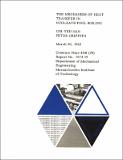| dc.contributor.author | Han, Chi-Yeh | en_US |
| dc.contributor.author | Griffith, P. | en_US |
| dc.contributor.other | Massachusetts Institute of Technology. Division of Sponsored Research. | en_US |
| dc.contributor.other | Massachusetts Institute of Technology. Heat Transfer Laboratory. | en_US |
| dc.date.accessioned | 2011-03-04T23:40:04Z | |
| dc.date.available | 2011-03-04T23:40:04Z | |
| dc.date.issued | 1962 | en_US |
| dc.identifier | 14072605 | en_US |
| dc.identifier.uri | http://hdl.handle.net/1721.1/61501 | |
| dc.description.abstract | A criterion is developed for bubble initiation from a gas filled cavity on a surface in contact with a superheated layer of liquid. It is found that the temperature of bubble initiation on a given surface is a function of the temperature conditions in the liquid surrounding the cavity as well as the surface properties themselves. It is also found that the delay time between bubbles is a function of the bulk liquid temperature and the wall superheat and is not constant for a given surface. By consideration of the transient conduction into a layer of liquid on the surface, a thermal layer thickness is obtained. With this thickness and a critical wall superheat relation for the cavity, a bubble growth rate is obtained. Bubble departure is considered and it is found that the Jakob and Fritz relation works as long as the true (non-equilibrium) bubble contact angle is used. The effect on the departure size of the virtual mass in the surrounding liquid is found to be negligible at one gravity. That is, at one gravity the primary effect of bubble growth velocity on bubble departure size is found to be due to contact angle changes. The initiation, growth and departure criterions are each experimentally, individually, checked. They are then used to compute the heat transfer near the knee of the boiling curve using only an experimental determination of the number of bubbles as a function of wall superheat and other known quantities. Finally the q vs. Tw - Tsat relation is computed and measured and compared. The comparison is satisfactory. | en_US |
| dc.description.sponsorship | Office of Naval Research DSR | en_US |
| dc.format.extent | v, 76 p | en_US |
| dc.publisher | Cambridge, Mass. : M.I.T. Division of Sponsored Research, [1962] | en_US |
| dc.relation.ispartofseries | Technical report (Massachusetts Institute of Technology, Heat Transfer Laboratory) ; no. 19. | en_US |
| dc.subject | Heat -- Transmission. | en_US |
| dc.subject | Boiling-points. | en_US |
| dc.subject | Bubbles. | en_US |
| dc.title | The mechanism of heat transfer in nucleate pool boiling | en_US |
| dc.type | Technical Report | en_US |
